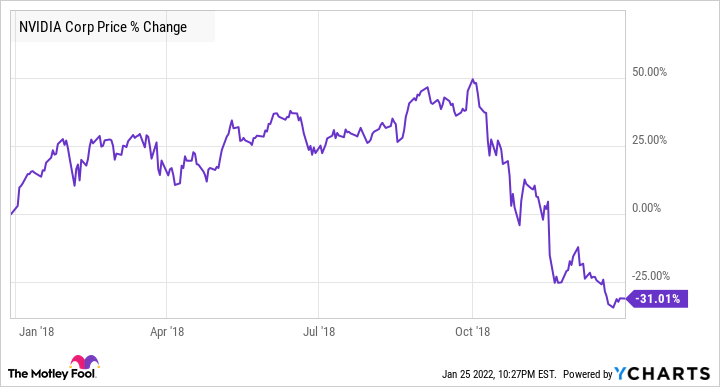Ever since Nvidia (NVDA 3.10%) released strong earnings results for the third quarter of fiscal 2022 on Nov. 17, 2021, the stock has been going downhill, due to a variety of factors out of the company's control.
Shares of the graphics card specialist are down 30% since its Q3 report as the strong probability of interest rate hikes by the Federal Reserve and the crash in cryptocurrencies has weighed on investor sentiment. After all, interest rate hikes are bad news for richly valued companies such as Nvidia as rising U.S. Treasury yields mean that investors can get more returns by shifting their money to safer assets.
NVDA data by YCharts
Additionally, the cryptocurrency sell-off could dent graphics card demand and cause a potential oversupply in the graphics processing unit (GPU) market. That's because miners won't invest in expensive hardware to mine cryptocurrencies due to lower profitability and may even put their GPUs up for sale. However, history suggests that savvy investors should consider taking advantage of the drop in Nvidia stock, as the multiple growth drivers it is sitting on could encourage a strong comeback.

Image source: Getty Images.
Nvidia has been in a similar situation before
Nvidia faced a similar predicament in 2018. The Fed raised interest rates four times that year. Additionally, graphics card demand had weakened because of a cryptocurrency crash that left manufacturers with excess inventory on their hands, leading to a drop in GPU prices. As a result, Nvidia stock lost its wheels in the final quarter of the year.
NVDA data by YCharts
However, it is worth noting that investors who took advantage of the drop in Nvidia stock at that time are sitting on nice gains right now. Shares of Nvidia rocketed higher over the next three years, crushing the broader market by a huge margin thanks to impressive growth in the company's revenue and earnings.
It won't be surprising to see history repeat itself.
NVDA data by YCharts
The company's terrific growth is here to stay
Investors shouldn't forget that Nvidia has been growing at a tremendous pace on the back of terrific graphics card demand and the growing need for data-center accelerators. These two catalysts propelled Nvidia's Q3 revenue to $7.1 billion, a 50% jump over the prior-year period. The company's adjusted earnings shot up 60% year over year to $1.17 per share.
Nvidia's fourth-quarter forecast indicates that its outstanding growth will continue. The company forecasts $7.4 billion in revenue this quarter, which would be a 48% jump over the prior-year period. The gaming and data center businesses will continue to drive the bulk of this growth as they together account for 87% of the company's total revenue.
Nvidia holds the biggest share in both fast-growing markets. Its share of the discrete GPU market, which is expected to hit $54 billion in revenue by 2025 from $23.6 billion in 2020, stands at 83%. The data-center GPU market is expected to hit $20 billion in revenue by 2027, growing at an annual rate of 42%, and Nvidia is in an ideal position to capture this terrific growth given its 80%-plus market share.
More importantly, Nvidia is on track to dig into hot tech trends such as the metaverse and self-driving cars. Wells Fargo estimates that the metaverse could create a $10 billion revenue opportunity for Nvidia over the next five years. The good part is that Nvidia is already on its way to tap this massive revenue opportunity. Its Omniverse Enterprise platform, which allows creators to create 3D worlds, has witnessed robust adoption since its launch.
On the other hand, Nvidia is sitting on $8 billion worth of design wins in the automotive market. The company expects to convert these design wins into revenue over the next five years, indicating that its automotive business is built for long-term growth after having generated $586 million in revenue over the trailing 12 months.
All this explains why analysts expect Nvidia's earnings to grow at an impressive annual rate of 40% for the next five years.
A golden opportunity to buy
Nvidia's dip in the past couple of months has made the stock relatively cheaper. It is now trading at 68 times trailing earnings as compared to 2021's earnings multiple of 90. The forward earnings multiple has also come down to 43 from last year's multiple of 57.
Nvidia stock isn't cheap by any means as those multiples point toward a significant premium to the Nasdaq-100 Index's price-to-earnings ratio of 35. But if Nvidia stock continues to decline in the near term, investors can get an opportunity to buy it at a cheaper valuation. So, Nvidia's drop is good news for growth investors as they have a window to buy this fast-growing tech company on the cheap, which could be a smart thing to do given its bright prospects.








